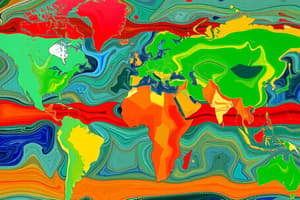Podcast
Questions and Answers
In a porous solid with open porosity e and large pore size compared to the mean free path of molecules, the diffusion coefficient D is inversely proportional to the porosity e.
In a porous solid with open porosity e and large pore size compared to the mean free path of molecules, the diffusion coefficient D is inversely proportional to the porosity e.
True (A)
The sinuosity coefficient of pores, s, is defined as the direct route traveled by a gas molecule in passing from one point to another inside the porous solid, distant one unit of length.
The sinuosity coefficient of pores, s, is defined as the direct route traveled by a gas molecule in passing from one point to another inside the porous solid, distant one unit of length.
False (B)
When the porous solid is a collection of spheres, the sinuosity coefficient is equal to r.
When the porous solid is a collection of spheres, the sinuosity coefficient is equal to r.
False (B)
Diffusion coefficient D in a porous solid is always greater than the coefficient D1 outside it.
Diffusion coefficient D in a porous solid is always greater than the coefficient D1 outside it.
In the transformation of a non-porous particle by a fluid, diffusion occurs through the boundary layer that surrounds the solid.
In the transformation of a non-porous particle by a fluid, diffusion occurs through the boundary layer that surrounds the solid.
A soluble or volatile product formed during a reaction allows diffusion through the solid itself.
A soluble or volatile product formed during a reaction allows diffusion through the solid itself.
The phenomena of reaction and diffusion in porous solids can be easily observed due to the movement of the interface.
The phenomena of reaction and diffusion in porous solids can be easily observed due to the movement of the interface.
The kinetic expression for reactions in dense solids is the same as that for reactions in porous solids.
The kinetic expression for reactions in dense solids is the same as that for reactions in porous solids.
In gas-solid reactions with porous solids, the flux of reactant gas is given by Fick's first law.
In gas-solid reactions with porous solids, the flux of reactant gas is given by Fick's first law.
The change of flux in a gas-solid reaction results from the accumulation of gas in the pores of the solid.
The change of flux in a gas-solid reaction results from the accumulation of gas in the pores of the solid.
Assuming D is constant, the equation for the flow of gas in a gas-solid reaction is $-F rac{dc}{dx} = D rac{ ext{d}^2(C-C_0)}{ ext{d}z ext{d}y}$.
Assuming D is constant, the equation for the flow of gas in a gas-solid reaction is $-F rac{dc}{dx} = D rac{ ext{d}^2(C-C_0)}{ ext{d}z ext{d}y}$.
The reaction velocity in gas-solid reactions is dependent on the volume of the porous solid.
The reaction velocity in gas-solid reactions is dependent on the volume of the porous solid.
The transformation of a porous particle by a gas is a simple and well-defined process.
The transformation of a porous particle by a gas is a simple and well-defined process.
In the case of scrap, there is no solution but only a question of heat absorption and diffusion.
In the case of scrap, there is no solution but only a question of heat absorption and diffusion.
The solution of a piece of refractory metal in liquid steel is a second-order reaction.
The solution of a piece of refractory metal in liquid steel is a second-order reaction.
Reactions at the interface and diffusion through the boundary layer in metallurgical processes act as two resistances in parallel.
Reactions at the interface and diffusion through the boundary layer in metallurgical processes act as two resistances in parallel.
When diffusion across the solid is very rapid, (4.26) and (4.44) describe the transformation of a particle in a chemical regime.
When diffusion across the solid is very rapid, (4.26) and (4.44) describe the transformation of a particle in a chemical regime.
In gas-solid reactions, chemical reactions and diffusion are separated in time.
In gas-solid reactions, chemical reactions and diffusion are separated in time.
Flashcards are hidden until you start studying




